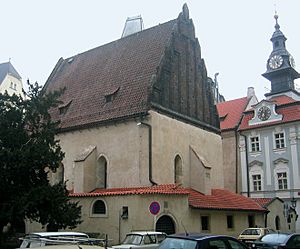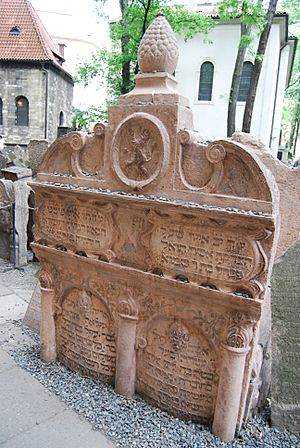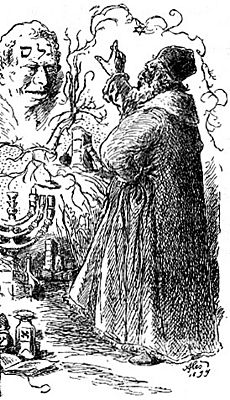Judah Loew ben Bezalel facts for kids
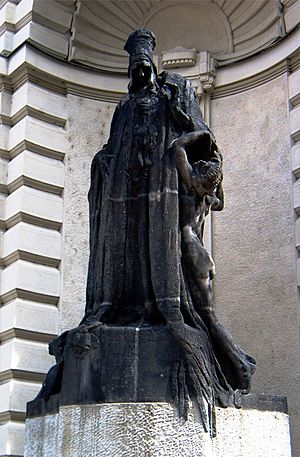
Ladislav Šaloun's statue of Loew at the New City Hall of Prague in the Czech Republic
|
|
| Religion | Judaism |
|---|---|
Quick facts for kids Personal |
|
| Born | between 1512 and 1526 Poznań, Poland |
| Died | 17 September 1609 Prague, Bohemia, HRE |
| Signature |  |
| Buried | Old Jewish Cemetery, Prague |
Judah Loew ben Bezalel (Hebrew: יהודה ליווא בן בצלאל), often called Rabbi Loew or the Maharal of Prague, was a very important Jewish scholar and thinker. He lived from around 1512 to 1609. For most of his life, he was a leading rabbi in the cities of Mikulov and Prague.
The Maharal was known for his deep understanding of Jewish philosophy and Jewish mysticism. He wrote many books, including Gur Aryeh al HaTorah, which explains the famous Rashi commentary on the Torah. He is also famous for a legend that says he created the Golem of Prague, a clay creature brought to life.
Contents
Who Was Judah Loew?
Judah Loew was likely born in Poznań, Poland. His family came from Worms. We don't know his exact birth year, but it was sometime between 1512 and 1526. His uncle, Jakob ben Chajim, was a very important rabbi for the entire Holy Roman Empire. His older brother, Chaim, was also a well-known scholar.
It's believed that Rabbi Loew taught himself a lot of what he knew. There are no records of him attending a formal religious school. This shows how incredibly smart and dedicated he was to learning.
What Does "Loew" Mean?
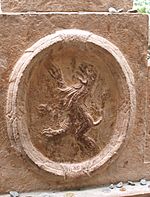
His name "Löw" or "Loew" comes from the German word for "lion". This is a special name often used for people named Judah or Yehuda in Hebrew. In the Book of Genesis, the leader Jacob called his son Judah a "Young Lion."
Rabbi Loew's famous book about the Rashi commentary on the Torah is called Gur Aryeh al HaTorah. In Hebrew, this means "Young Lion [commenting] upon the Torah." His tombstone in Prague even has a lion with two tails on it. This lion is a symbol for both his name and for Bohemia, where Prague is located.
His Career as a Rabbi
In 1553, Rabbi Loew became the chief rabbi of Moravia in Mikulov. He helped manage the Jewish community there. He also decided which parts of the Talmud should be studied in different towns. He even updated the rules for how the community elected its leaders and collected taxes. He retired from this role in 1588, but people still looked to him for guidance for many years.
One important thing he did in Moravia was to fight against false rumors, called Nadler, that were spread about families. These rumors could make it very hard for young people from those families to find someone to marry. He spoke out strongly against this problem.
He moved back to Prague in 1588 and became a rabbi there again. He continued to speak out against false rumors. In 1592, he even met with Emperor Rudolf II. They talked about Kabbalah, which is Jewish mysticism. The emperor was very interested in this topic.
Later in 1592, Rabbi Loew moved to Poznań, where he was chosen to be the Chief Rabbi of Poland. While in Poznań, he wrote some of his important books, like Netivoth Olam.
His Influence and Students
Rabbi Loew had many students who became important scholars themselves. Two of his main students in Prague were Rabbis Yom-Tov Lipmann Heller and David Gans. Rabbi Heller encouraged everyone to study the Mishnah regularly. David Gans wrote books on Jewish and general history, and also about astronomy. Both Rabbi Loew and David Gans even knew Tycho Brahe, a famous astronomer.
Rabbi Loew's many philosophical books became very important in Jewish thought. He didn't openly teach Kabbalah in his books. Instead, he tried to make the deep ideas of Kabbalah understandable to everyone by writing them in a clear, philosophical way. He believed that only the greatest scholars could fully understand Kabbalah. So, while his writings included Kabbalistic ideas, they were always presented in a logical and thoughtful manner.
He also strongly disagreed with people who tried to explain Jewish wisdom using only science. He believed that the teachings in the Talmud and Midrash were much deeper than what science could explain. However, he was still in favor of scientific research, as long as it didn't try to go against divine teachings.
His ideas inspired the Hasidic movement in Poland. They also influenced later scholars from Lithuania and Latvia, like Rabbi Eliyahu Eliezer Dessler and Rabbi Abraham Isaac Kook.
His Family and Death
Rabbi Loew was married to Pearl. They had six daughters and one son, Bezalel, who also became a rabbi but passed away early. Rabbi Loew was wealthy, probably from his father's successful businesses.
He moved back to Prague near the end of his life and died there in 1609. He is buried in the Old Jewish Cemetery, Prague, and you can still visit his grave today.
His Descendants
Many famous people are descendants of Rabbi Loew. These include Rabbi Shneur Zalman of Liadi, who started the Chabad Hasidic movement, and the famous violinist Yehudi Menuhin. Other descendants include Rabbi Nachman of Breslov and the scientist Theodore von Kármán.
Some well-known researchers in the field of Artificial Intelligence, like Gerald Sussman, Marvin Minsky, and Joel Moses, also believe they are descendants of Rabbi Loew.
The Legend of the Golem
Rabbi Loew is most famous for the legend of the golem. The story says he created a creature out of clay to protect the Jewish people in the Prague Ghetto from attacks and false accusations. He supposedly used special mystical knowledge to bring the golem to life, similar to how God created Adam.
Most historians believe this legend was created in Germany in the early 1800s. The first known written version of the story appeared in an 1834 book. Since then, the story has been told and changed many times.
His Writings
Rabbi Loew started publishing his books when he was quite old. His first book, Gur Aryeh ("Young Lion"), was published in 1578 when he was 66. It was a detailed commentary on Rashi's commentary on the Torah. Four years later, he published Gevuroth HaShem ("God's Mighty Acts").
Here are some of his important works:
- Gur Aryeh ("Young Lion", Prague 1578) - A commentary on Rashi's explanation of the Torah.
- Gevuroth Hashem ("God's Mighty Acts", Cracow 1582) - About the holiday of Passover and the miracles of the the Exodus.
- Derech Chaim ("Way of Life", Cracow 1589) - A commentary on the Mishnah tractate Avoth.
- Netivoth Olam ("Pathways of the World", Prague 1595-1596) - A book about ethics and how to live a good life.
- Be'er ha-Golah ("The Well of Exile", Prague 1598) - Explains the stories and teachings found in the Talmud and Midrash.
- Netzach Yisrael ("The Eternity of Israel", Prague 1599) - About Tisha B'Av (a day of mourning) and the future redemption of the Jewish people.
- Tif'ereth Yisrael ("The Glory of Israel", Venice 1599) - A philosophical look at the Torah, meant for the holiday of Shavuot.
- Or Chadash ("A New Light", Prague 1600) - About the holiday of Purim.
- Ner Mitzvah ("The Candle of the Commandment", Prague 1600) - About the holiday of Hanukkah.
Many of his books about holidays have titles inspired by a Bible verse that talks about God's greatness, might, glory, and victory.
Commemoration
In April 1997, the Czech Republic and Israel released special stamps, and one of them showed Rabbi Loew's tombstone. In May 2009, the Czech Post issued another stamp to mark 400 years since his death. In June 2009, the Czech Mint also made a special coin to remember him.
See also
 In Spanish: Rabbi Judah Loew para niños
In Spanish: Rabbi Judah Loew para niños
- Kerem Maharal, a village in Israel named after him.
- Statue of Judah Loew ben Bezalel, Prague
Images for kids


